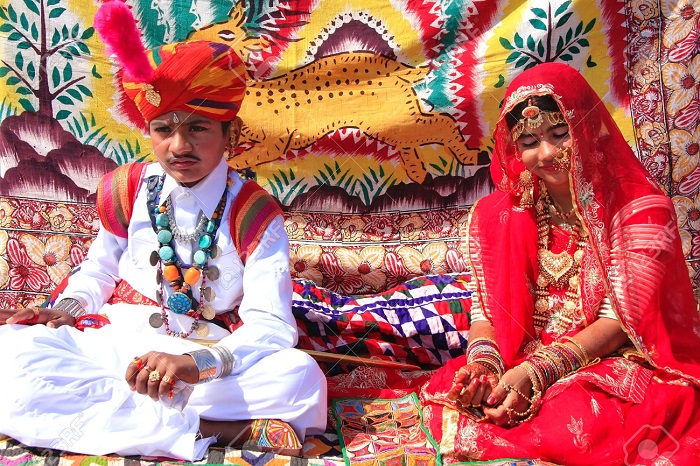India has always been exalted and remembered fondly as the country of symbolic colors. To an outsider, its colorful culture, streets, and stories seem like a page out of an ancient folk tale. But color, in essence, has been a large part of the Indian consciousness.
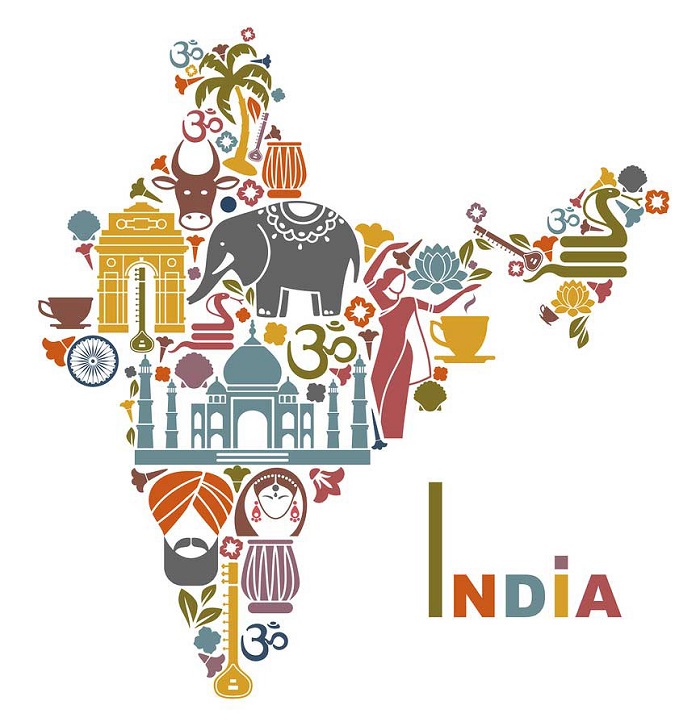
Symbolic Colors of India
From the deep orange marigold flowers that bejewel almost every celebration to the deep hues of red that deck up the bride on her most important day, color in India has, over time, become synonymous with religion – an expression of faith and beliefs. In a country where a deep understanding of the prevalent diversity is perhaps the only common thread that ties its people together, India is a magical experience that ought not to be missed.
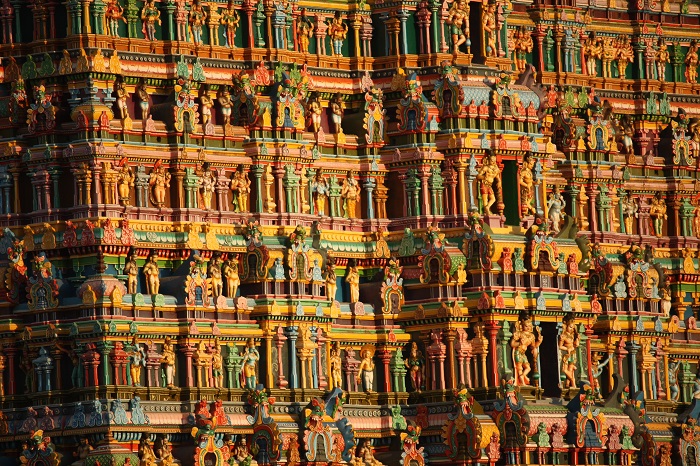
Menakshi Temple, Madurai, Tamil Nadu, India
In a country as diverse and culturally vibrant as India, it is perhaps the common, simple expressions of color that hold together the multitudes of outlooks, lifestyles, and traditions. The symbolism of color stands out and controls every aspect of life in India, be it religion, politics, festivals, or celebrations. In India, be it the north, south, west, or east, color and culture go hand in hand. Just like many other cultures across the world, there are some typical classifications of color to be found in India.
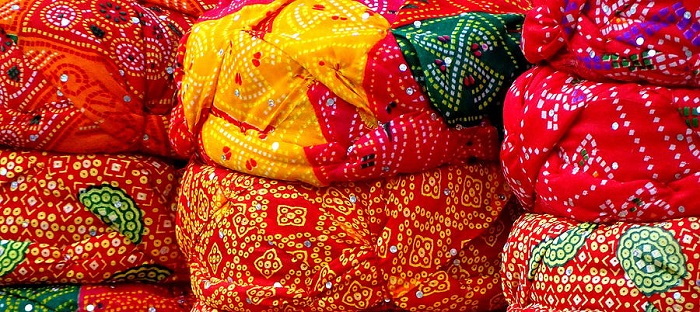
Colorful turbans for sale in Jaisalmer, Rajasthan, India
Black in India has connotations with lack of desirability, evil, negativity, and inertia. It represents anger and darkness and is associated with the absence of energy, barrenness, and death. Black is used as a representation of evil and is often used to ward off evil. This can be found in an age old custom amongst Indians where an infant or, for that matter, anyone looking really spectacular is often traditionally blessed with a little black dot on the chin or under the ear to ward off the evil eye. And while white stands for everything desirable in the west, in India it takes on a more somber connotation.
White is the absence of color, and is the only color widows are allowed to wear. It is the acceptable color at funerals and ceremonies that mark death in the family. It reflects the basic quality of the color itself, in principle; white, as a color, repels all light and colors and therefore, when a widow wears white, she disconnects herself from the pleasures and luxuries of active and normal participation in society and life around her. White is also widely accepted as the color of peace and purity and is diametrically opposite to red, the color of violence and disruption in the southern half of India.
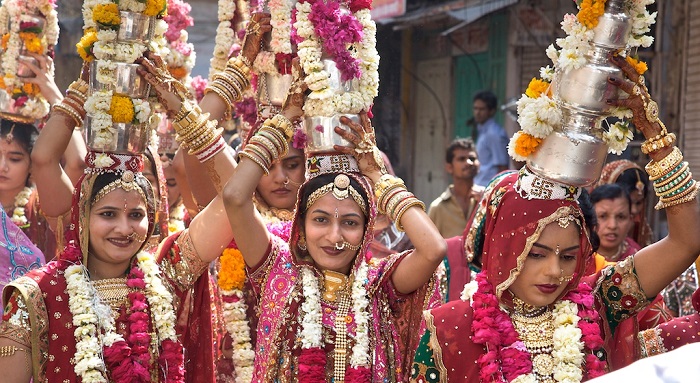
Colorful turbans for sale in Jaisalmer, Rajasthan, India
Red is dynamic and constantly breathing fire in the eyes of the beholder. It incites fear and is the color associated with one of the most revered goddesses in Hindu mythology – Durga. Her fiery image is enhanced by her red tongue and almost red eyes. Red also stands for purity and is the preferred color for a bride’s garment. Red has a deep meaning in the Indian psyche.
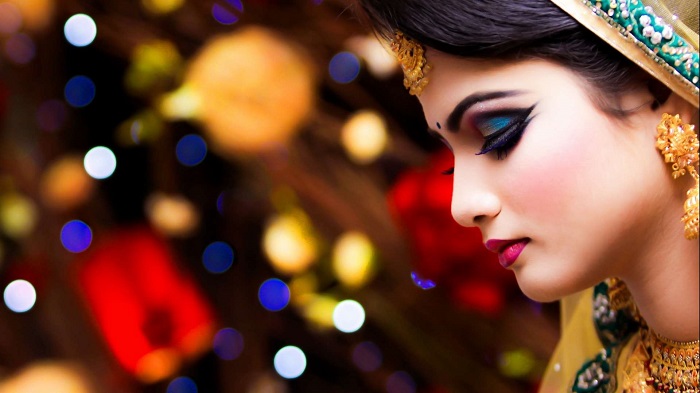
A beautiful bride
It commemorates the union between two people and is visible right from the wedding, where the bride is decked in brilliant hues of red to the red tikka (spot on forehead) that she adorns after the wedding as a sign of her commitment. It is perhaps easy to see why red also symbolizes fertility and prosperity. It is the color of the fertile clay that reaps harvests and better lives and is used widely in prayer ceremonies and offerings. And India could hardly be celebrated as the land of spices without its most feisty ingredient — chilies. And while red symbolizes fertility and purity, it also connotes a certain sensuousness and demands positive energy.
India: Home To Myriad Symbolic Colors
Because of the obvious diversity in its population, India is home to myriad interpretations and representations of symbols and colors. Colors represent different emotions to people living in different regional, geographical, and religious divides. And perhaps certain colors that have a special place in a particular area may not necessarily enjoy a similar status elsewhere. Some of the universally celebrated colors find their origins in the spices that are used widely across geographic and religious divides. Turmeric, for instance, while being used for cooking in both the north and the south, is also used in ceremonies offering prayers and marriages. Yellow symbolizes sanctity and is an essential herbal ingredient applied on the body and face by women in the sub continent. In a country steeped in religious beliefs, the origin of most colors lies in the powers and mythical lives of its gods.
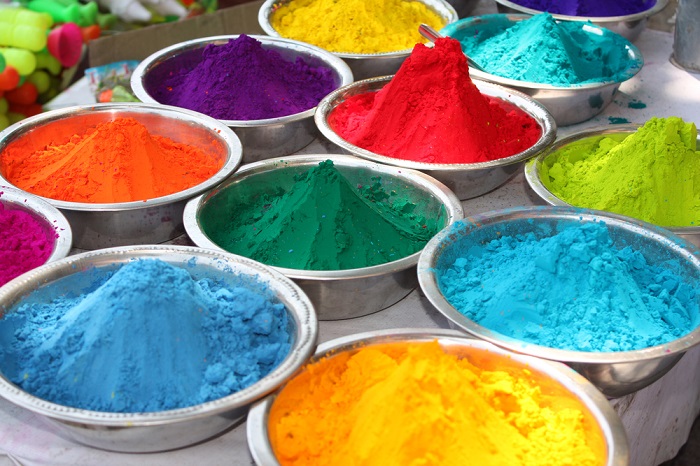
Colorful Tika Powders at the Orcha Market in India
The color blue, for instance, is associated with Lord Krishna, perhaps one of the most favored gods in India. And, as is obvious for any agricultural economy, green symbolizes a new beginning, harvest, and happiness. It is also the revered color of Islam, a large religious presence in India.
Green symbolizes nature and therefore is a manifestation of God himself. India is steeped in tradition, culture, and a rich and a fabulous history. Kings and kingdoms, saints and followers, rebels and fighters have traversed the paths of its glorious past and have all played a small but significant role is ascertaining the perception of color today.
Some of the glaring differences between the perception of color in the West and the East are due to the simplest elements in history. Royalty, in the West and in the Christian culture, is represented by a deep, mystical shade of purple, while in India, it is the deep hues of red and ochre that symbolize wealth and grandeur. Perhaps one of the most poignant factors in the perception of colors in the Indian psyche is the religious undertones that coexist at almost every phase of an “Indian’s life.”
Today, colors are used as symbols of fear, conformity, and blind faith across the country monopolized by the contorted ways of politics. Yet India remains colorful and vibrant in more ways than one. It stands strong as perhaps the most stoic example of unity in a world so divided. And the colors that hold it together are the colors of faith, pride, and love – feelings that overcome all differences.
The colors of India have mesmerized rulers, outsiders, and visitors – perhaps more so because of the stories and legends that bind its people, its culture, and its beliefs. The “rani” pink of mystical Rajasthan, the pastel hues of southern India, the joyous, bright hues of the northern frontier, and the balmy bright colors of the east offer a kaleidoscopic insight into an almost perfect blend of history and modernism. And perhaps a trip down its many roads will lead you to an understanding of its pulse. Maybe you’ll take the road untaken and bring home a whole new hue to your life.
